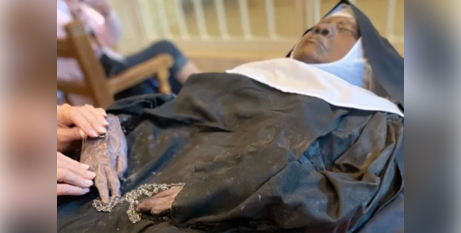
Hundreds of pilgrims have descended on a Benedictine monastery for religious sisters in rural Missouri after exhumed remains of the contemplative order’s African-American foundress appear to be incorrupt, four years after her death. Source: CNA.
Sister Wilhelmina Lancaster OSB founded the Benedictine Sisters of Mary, Queen of the Apostles — best known for their chart-topping Gregorian chant and classic Catholic hymn albums — in 1995 at the age of 70, leaving the Oblate Sisters of Providence, her community of over 50 years, to do so.
Known for her devotion to the Traditional Latin Mass and her faithfulness to Benedictine contemplation and the Liturgy of the Hours, she died at age 95 on May 29, 2019, on the vigil of the solemnity of the Ascension.
Roughly four years later, on the solemnity of the Ascension in the Latin rite, the abbess and sisters decided to move her body to a final resting place inside their monastery chapel, a long-standing custom for founders and foundresses.
Expecting to find bones, the Benedictine Sisters instead unearthed a coffin with an apparently intact body, even though the body was not embalmed and the wooden coffin had a crack down the middle that let in moisture and dirt for an unknown length of time during those four years.
“We think she is the first African-American woman to be found incorrupt,” the abbess of the community, Mother Cecilia, OSB, told EWTN’s ACI Group on Saturday. As the head of the monastery, it was her role to first examine what was in the coffin.
The body was covered in a layer of mould that had grown due to the high levels of condensation within the cracked coffin. Despite the dampness, little of her body and nothing of her habit disintegrated during the four years.
The Church has a long-standing tradition of so-called “incorruptible saints”, so called because years after their death parts of or even the entirety of their bodies are immune to the natural process of decay.
FULL STORY
A miracle in Missouri? Body of Benedictine Sisters’ foundress thought to be incorrupt (By Kelsey Wicks, CNA)






